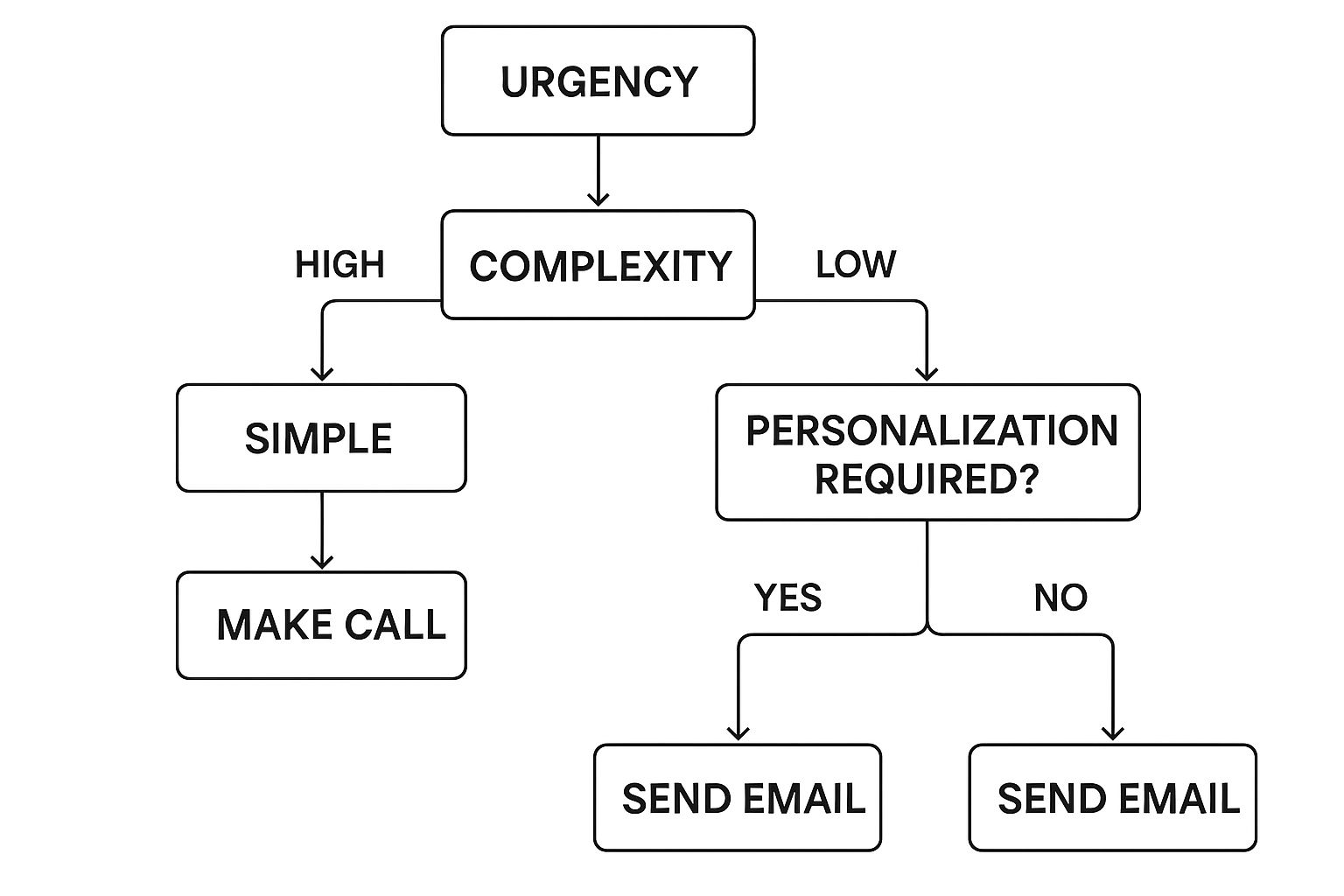Cold Email vs Cold Call: Which Works Better for Your Business?
- Prince Yadav
- Jun 11
- 11 min read
The Real Story Behind Cold Email vs. Cold Call Performance
This isn't about crowning a champion in the "cold email vs. cold call" arena. It's about understanding which method performs best in specific sales situations. My experience working with sales teams reveals a consistent theme: success hinges on aligning your outreach with your target audience and overall sales strategy. This means recognizing the nuances of how prospects engage with each communication style.
Let's consider cold calling. It offers the advantage of immediate interaction and the opportunity to quickly build rapport. This can be invaluable for complex products or services where real-time clarification is essential. However, cold calling can also be intrusive. Reaching decision-makers is increasingly difficult, often requiring navigating gatekeepers and caller ID screening.
As the Wikipedia entry on cold calling illustrates, these obstacles can make it a resource-intensive endeavor.
Cold email, in contrast, offers the flexibility of asynchronous communication. Prospects can absorb information at their own pace, which can be particularly effective when introducing new concepts or presenting detailed information. This approach also allows for greater scalability, enabling you to reach a wider audience with consistent messaging. Learn more about using cold email to get more customers.
However, cold email presents its own set of challenges. Cutting through inbox clutter and grabbing attention requires a strategic approach to crafting compelling subject lines and valuable email content.
The core difference between cold email and cold calling lies in how prospects control the interaction. This impacts both response rates and ultimately, conversions. Understanding this dynamic is key to optimizing your outreach and maximizing your return on investment.
Response Rates That Matter: Beyond Surface-Level Numbers

The discussion around cold emailing versus cold calling often revolves around response rates. But simply focusing on the percentages can be a trap. A high response rate doesn't necessarily translate to a successful campaign.
For example, imagine a cold email campaign with a 20% response rate. Sounds impressive, right? But what if most of those responses are unsubscribes or automatic replies? The real value diminishes considerably.
This highlights why response quality is as important as quantity. A lower response rate from cold calling, perhaps 10%, might actually be far more effective. If those conversations lead to engaged prospects and qualified leads, they hold significantly more weight.
This difference often boils down to the core of the interaction. Cold calls, while more difficult to connect, offer immediate two-way communication. This allows for deeper engagement and real-time qualification.
Cold email response rates can be particularly tricky. They typically range from 15% to 25%. This means for every 100 emails sent, you might get 15 to 25 responses. However, these responses are often short and don't always translate into meaningful engagement.
Cold calls, in contrast, can achieve a richer form of engagement. Connecting with someone live is a challenge, with only about 1-3 out of 10 calls reaching a real person. However, the immediacy and personal touch of a call can sometimes result in a higher quality response than email. Explore this further in this insightful blog post.
The potential for follow-up also differs significantly. A short email reply doesn't always offer much to build on. A conversation, even a brief one, can provide valuable insights into a prospect’s needs and create opportunities for future engagement.
This is where the real power of cold calling often lies. The ability to adapt your message in real-time and tailor your pitch to the individual prospect can greatly improve the chances of a meaningful connection and, ultimately, a conversion. Focus on the relevance of responses, rather than simply pursuing high open or reply rates, for true long-term sales success.
Conversion Reality Check: What Actually Drives Revenue

Beyond initial responses lies the critical question: which approach, cold emailing or cold calling, truly fuels revenue growth? The answer isn't as simple as counting conversions. It's about the quality of those conversions. Experienced sales teams know a single high-value client can often outweigh dozens of smaller accounts.
For instance, imagine a SaaS business targeting enterprise customers. Cold calling might yield a lower conversion rate, but the contracts secured could be substantially larger, ultimately driving greater revenue. Conversely, a company selling a lower-priced product might see higher conversion rates from cold email contribute more significantly to their bottom line. Conversion rates alone don't tell the whole story.
Analyzing Conversion Rates and Their Significance
Cold emails typically achieve conversion rates between 1% and 5%, averaging around 3%. This translates to roughly 1 to 5 conversions for every 100 emails sent. Cold calling, in contrast, can reach higher conversion rates, sometimes as high as 10% for top performers, though 2% is a more realistic benchmark. Discover more insights. This variance highlights the importance of aligning your outreach strategy with your specific sales objectives.
Let's delve into a more detailed comparison of conversion performance between these two strategies. The following table provides a comprehensive overview:
Conversion Performance Analysis: Email vs Phone Outreach
Comprehensive comparison of conversion metrics and quality factors between cold email and cold calling strategies
Conversion Factor | Cold Email Performance | Cold Call Performance | Strategic Implication |
|---|---|---|---|
Conversion Rate | 1% - 5% (avg. 3%) | 2% - 10% (avg. 2%) | Cold calling can yield higher conversion rates, but averages are similar. Focus on quality over quantity. |
Deal Size | Can vary widely; often smaller deals in higher volume | Potential for larger individual deals | Align outreach with your target customer profile and ideal deal size. |
Sales Cycle Length | Longer, requiring nurturing | Potentially shorter, more direct engagement | Consider your sales cycle timelines and resource allocation. |
Customer Lifetime Value | Potential for high CLTV through nurturing and relationship building | Can also yield high CLTV, particularly with enterprise clients | Prioritize strategies that maximize long-term customer value. |
As this table illustrates, the "best" approach depends heavily on your specific sales context. While cold calling might offer higher conversion rates in some scenarios, cold email can build stronger relationships over time, leading to higher customer lifetime value.
The Impact of Sales Cycle Length
The length of the sales cycle also plays a critical role. Cold calling, with its immediate interaction, can sometimes accelerate the sales process, leading to faster conversions. Cold email, while potentially slower, allows for nurturing leads over an extended period, building trust and fostering stronger connections before closing a deal. Effective cold email examples to boost your outreach.
Measuring True Revenue Impact
Measuring conversion success requires looking beyond simple percentages. Factors like deal size, sales cycle length, and customer lifetime value paint a more accurate picture of each method's true revenue impact. This holistic perspective empowers sales teams to optimize their strategies for sustained growth and profitability, not just short-term gains. By analyzing these deeper metrics, businesses can pinpoint which approach generates the most qualified opportunities and best aligns with their overall revenue goals.
Resource Investment Reality: The True Cost of Each Approach

After examining conversion rates, let's dive into the resource implications of cold emailing versus cold calling. Effective resource allocation is paramount for successful sales leadership. This means understanding the full cost picture, not just the surface-level expenses.
Cold emailing presents clear advantages in scalability and cost-effectiveness. Automation tools like Mailchimp empower businesses to reach thousands of prospects with minimal manual input. This translates to a potentially higher return on investment, especially compared to the labor-intensive nature of cold calling.
This efficiency is amplified by automated follow-up sequences and detailed campaign analytics. Studies suggest email outreach can deliver up to twice the ROI of cold calling, largely due to automation saving time and resources. Learn more about the potential of email outreach.
However, cold emailing costs extend beyond software subscriptions. Consider the investment in compelling copywriting, list management, and ensuring deliverability. Monitoring campaigns and making data-driven adjustments also require dedicated time and expertise. For timing optimization, check out this resource: best time to send cold emails.
Evaluating Cold Calling Costs
Cold calling, while often perceived as more expensive, involves different cost considerations. The primary expense is usually human capital: salaries, training, and sales team management. Additional investments include phone systems, call tracking software like HubSpot, and other infrastructure.
While the initial investment might seem higher, the potential for immediate, high-quality engagement can justify the cost, particularly for complex sales or high-value clients.
Understanding the Complete Resource Investment
To accurately calculate the true cost per acquisition for each method, you must factor in the less obvious expenses. This includes:
Training costs
Technology infrastructure
Opportunity costs
Quality assurance measures
Understanding these nuanced costs allows for a more informed comparison. This empowers sales leaders to make strategic decisions about resource allocation.
The following table summarizes the key resource factors to consider:
Complete Resource Investment Analysis Detailed breakdown of time, cost, technology, and scalability requirements for both outreach methods
Resource Factor | Cold Email Requirements | Cold Call Requirements | Business Impact |
|---|---|---|---|
Time | Lower initial investment, ongoing monitoring | Higher initial investment for training and execution, potentially faster results | Depends on sales cycle length and complexity |
Cost | Software subscriptions, copywriting, list management | Salaries, phone systems, call tracking software | Scalability influences overall cost-effectiveness |
Technology | Email marketing platforms, automation tools | CRM, phone systems, dialer software | Integration with existing systems is key |
Scalability | Highly scalable with automation | Limited scalability dependent on team size | Impacts reach and potential customer volume |
As this table highlights, each approach has different resource demands. Cold email excels in scalability, while cold calling requires more upfront investment in human capital and infrastructure.
Choosing the Right Approach
The optimal approach depends on factors like:
Your business objectives
Target market
Sales cycle length
Cold emailing excels in high-volume scenarios. Cold calling becomes more attractive for complex, high-value deals requiring personalized interaction. By analyzing the complete cost picture, businesses can pinpoint the scalability thresholds where each method makes financial sense. This allows you to align outreach strategies with overall growth stage and resource capabilities.
Strategic Context: When Each Method Truly Dominates
The best sales teams don't just randomly choose between cold emailing and cold calling. They strategically select the approach that aligns with their objectives and target audience. This section explores how top sales professionals decide when email outperforms calls, and vice versa.

This infographic offers a decision tree to help you choose between cold emailing and calling. It considers factors like urgency, complexity, and the level of personalization required. The visual makes it clear: urgent, simple situations often call for a phone call. However, complex sales needing a personal touch often benefit from email’s detailed approach. Understanding your specific sales context is key for effective outreach.
Think about a time-sensitive offer for a simple product. A quick cold call is likely the best way to connect and close. For example, discounted event tickets with limited availability demand a direct approach. On the other hand, pitching complex software to a C-suite executive requires a more thoughtful, personalized email. This allows for careful consideration and demonstrates respect for their time. Knowing your buyer persona and their preferred communication style is essential.

This screenshot from Wikipedia’s Sales Process page shows the different stages of a typical sales cycle. Knowing where your prospect is in this cycle informs your communication strategy. Early-stage prospects often appreciate the information-rich nature of email. Late-stage prospects, ready to discuss specifics, may prefer a direct phone call to iron out details.
For instance, introducing a new SaaS product to a potential client is often best done through email. This allows them to explore features and benefits at their own speed. However, a prospect who has downloaded a trial and explored the software might be ready for a direct conversation via a cold call. This tailored approach improves conversion rates by aligning communication with the buyer’s journey.
Industry Nuances and Personalization
Certain industries, such as finance or high-end consulting, often rely on strong relationships and personal connections. This often makes cold calling a more effective initial approach. For more in-depth information, check out our guide on effective outbound lead generation strategies.
Ultimately, adapting your strategy based on industry norms, deal complexity, and individual buyer preferences will greatly influence your success. This nuanced approach ensures your outreach resonates with the right audience at the right time, maximizing your return on investment.
Implementation Mastery: Strategies That Actually Deliver Results
This section explores practical strategies for cold emailing and cold calling, drawing from the experiences of successful sales teams. We'll delve into the techniques that distinguish impactful outreach from generic attempts, from crafting compelling email subject lines to delivering captivating call openings.
Mastering Cold Email Execution
Effective cold email hinges on delivering the right message to the right person at the right time. It all begins with meticulous list building. Targeting the correct prospects significantly impacts your response and conversion rates. For instance, a SaaS company selling project management software should target project managers, not CEOs.
Next, craft compelling subject lines. Think of them as headlines designed to grab attention and encourage opens. A subject line like "Streamlining Your Project Workflow" is far more effective than a generic "Introducing Our Software."
The email body itself must offer genuine value. Focus on addressing the recipient's pain points and providing solutions. Steer clear of lengthy sales pitches. Instead, offer valuable insights or resources relevant to their industry.
A strong call to action is also critical. Clearly state the desired next step, whether it's scheduling a demo or downloading a whitepaper.
Finally, consistent follow-up is key. A well-timed sequence of emails can nurture leads and keep your business top-of-mind. Tools like Mailchimp enable automation and personalized follow-up sequences, ensuring your message resonates and maximizing your chances of converting prospects into clients.
Excelling at Cold Calling Execution
Successful cold calling requires preparation, a clear message, and the ability to adapt. Before even dialing, research your prospect. Understand their role, company, and potential challenges. This allows for a more personalized and engaging conversation.
Your opening statement is crucial. It needs to capture attention and establish relevance immediately. Instead of a generic introduction, try referencing a recent company achievement or industry trend. This demonstrates you've done your homework.
Throughout the call, actively listen and respond to the prospect’s needs. Don’t just recite a script; engage in a genuine conversation. Address their specific concerns and build rapport.
If a prospect expresses disinterest, don’t push. Politely thank them for their time and move on. Respect their time and focus your efforts on more receptive prospects.
Finally, document each interaction. A CRM system like HubSpot helps track progress and personalize future communication. This diligent record-keeping enables a more targeted and strategic approach to future follow-up.
Optimizing and Scaling Your Outreach
Regardless of your chosen method, continuous improvement is essential. Track key metrics like open rates, response rates, and conversion rates. This data provides valuable insights into what’s working and what needs adjustment.
A/B testing subject lines, email copy, and call scripts can help identify optimal approaches. Refine your messaging based on data and continuously strive for better results.
Scaling your outreach requires a structured approach. For cold email, this involves segmenting your audience and tailoring messages for specific groups. Personalization is key to standing out in a crowded inbox.
For cold calling, consider investing in sales training and developing clear processes for lead qualification and follow-up. This ensures consistent messaging and maximizes effectiveness, regardless of scale.
By implementing these strategies, you can dramatically improve your cold outreach results, whether through email or phone. Remember, consistent effort and a data-driven approach are vital for long-term success. The true power lies in choosing the right method and executing it effectively, maximizing your reach and converting more prospects into loyal clients.
Your Strategic Decision Framework: Choosing The Right Path
Choosing between cold emailing and cold calling isn't a simple A/B test. It's about strategically aligning your outreach with your specific business goals and target market. Think of it as building a custom-fit suit rather than grabbing something off the rack.
Understanding Your Target Market
First, consider your target market characteristics. Where do your ideal customers spend their time? Are they glued to their inboxes or constantly on the phone? Senior executives, for instance, are often more accessible via a well-crafted email than a cold call. On the other hand, a small business owner might appreciate the personal touch of a direct conversation.
Another key element is deal complexity. For straightforward transactions, the speed and directness of cold calling can be highly effective. However, for more complex sales requiring in-depth explanations, cold email allows you to deliver comprehensive information and nurture leads through targeted follow-up sequences.
Evaluating Your Resources
Resource availability plays a crucial role in your decision-making process. Cold calling demands a significant investment in personnel, training, and call tracking systems like HubSpot. While cold email requires initial setup and ongoing optimization, it offers greater scalability and lower ongoing costs, allowing you to reach a broader audience with a leaner team. For more on effective lead generation strategies, check out this resource: B2B Lead Generation That Actually Works: Real Strategies.
Testing and Refining Your Approach
Regardless of your chosen path, testing is paramount. Begin with a small pilot campaign to assess effectiveness and pinpoint areas for improvement. Track key performance indicators (KPIs) such as response rates, conversion rates, and cost per acquisition. This data-driven approach empowers continuous refinement and optimization.
Remember, meaningful results take time and consistent effort. Don't get discouraged if you don't see overnight success. Establish clear success metrics and track your progress diligently. Use this data to inform adjustments and determine when to pivot or even combine approaches.
Maintaining Flexibility
Finally, building a sustainable outreach system requires flexibility. As your business grows and your target market evolves, your ideal approach may change. Stay adaptable, monitor performance, and be open to refining your strategy. This commitment to continuous improvement ensures your outreach remains effective and aligned with your ever-changing business objectives.
Ready to elevate your B2B lead generation? Contact Fypion Marketing today for a free consultation and learn how our performance-driven approach delivers qualified leads and fuels revenue growth.
Comments